
|
Tweet
Follow @sheldonbrowncom |

I own and love lots of bikes, but almost all of them have traditional lugged steel frames. This is the technology I grew up with, and as a result it is also the technology I'm most comfortable with. My experience with some of the newer materials and technologies is more limited, and I'm perhaps overdue to put some miles on a more 21st century style bike.
At the Interbike Outdoor Demo in October 2005, one of the bikes I test rode was a Raleigh Cadent 4.0, and I was very favorably impressed with it.
In February 2006, I acquired a Raleigh Cadent 4.0 of my own. I'm writing in early march, after only a couple of weeks with the bike--a couple of very cold weeks, and so far I've only got perhaps 60 miles on the bike, but it's enough to give a preliminary assesment.
![]()
![]()
The outstanding feature of the Raleigh Cadent line is the frame geometry, particularly the rider "cockpit." These bikes are intended to provide high-performance, light weight rides for riders who are not racers and are not comfortable in the extremely low position used by racers. The top tube is shorter than the current fashion for racing-type bikes, and the head tube is taller than usual. The result is that the handlebars are a much easier reach than a pure racing style bike provides. This has always been a problem for me, specifically because I have long legs and a short upper body. The Cadent is the first drop-bar bike I've ever ridden that give me a comfortable riding position with the stock handlebar stem! It's not for everybody...super fit riders with long upper bodies and short legs are liable to feel cramped by this frame design, but it works very well for me, an, I suspect, for a lot of other folks whose needs have been ignored by the proliferation of bikes designed for twentysomething ectomorphs.
This is not a touring bike, however. It is a quite sporty machine. Raleigh's category description is "Performance Comfort Road." My "large" size bike tips the scales at 20.5 lbs, very light for such a large bike.
It comes with Vittoria 25 mm tires, and they are about as wide as it would be possible to fit through the tight clearance of the frame and fork.
This bike is intended for sporty day rides, club rides, centuries, "disease rides" and the like, it is not intended to be a pack mule, nor to be an all-weather commuter.
It would also work for "credit card" touring in dry climates, but it is not a bike you would want to ride in the rain since there's no room for fenders.
The Truvativ Elita crankset has 52, 42 and 30 tooth chainrings. This is atypical of 10-speed stuff, as Shimano's "10-speed" triple cranksets use a 39 tooth middle.
Personally, I think the 42 is a better choice, unless you are going with a super tight cassette. With the 12-25 that comes stock on the Cadent 4.0, I find I can climb most hills just fine in the 42, and can also cruise along pretty well in that ring with less pressing need to shift to the 52 than would be the case if the middle ring were a 39.
The crankset uses the two-piece, external bearing design pioneered by Shimano's "Hollowtech II" models. Works just fine and it is nice and light.
The main triangle of the frame is Easton Ultralite Race aluminum, bonded to an Easton EC90 carbon rear triangle. The fork is all carbon, with a 1 1/8" integrated headset.
It has Shimano Ultegra brakes, Derailers, Brifters and Cassette, Truvativ Elita two-piece crankset with external bearings.
The wheels are no-name hubs, with Alex AT-400 rims, 28 spokes front and rear. The Alex rims look very similar to my favorite Mavic rim, the Open Pro. 28 spokes is a fair compromise between traditional 32/36 spoke wheels and the currently trendy boutique wheels with far fewer spokes. I'm afraid that the current trend in road bikes is to treat the wheels as "disposable/consumable" parts like tires and brake pads.
Anyway, so far the wheels are holding up fine under my 235 pounds.
![]()
![]()
I have not felt the need to customize the gearing on this bike, still running the stock 12-25 cassette:
| Gain Ratios | GearInches | Meters |
|---|---|---|
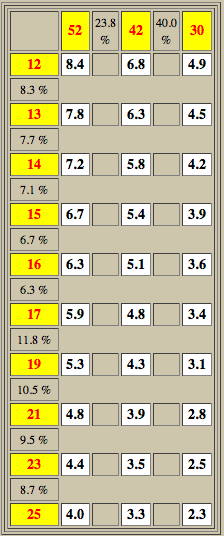
|
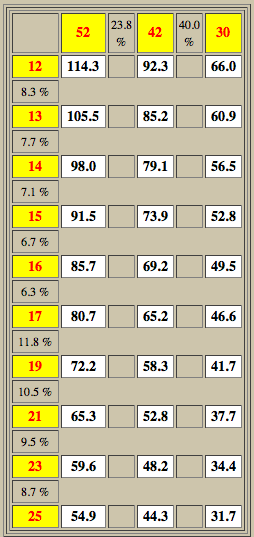 |
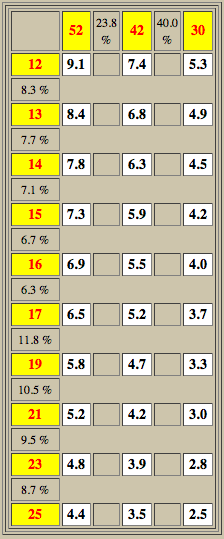 |
Well, the charts above are no longer accurate, because I replaced the 30 tooth chainring with a 26 tooth one. Due to my health issues, I'm needing lower gearing than I used to.
![]()
![]()
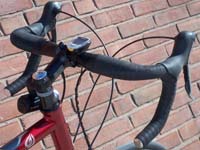 |
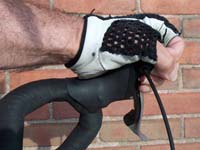 |
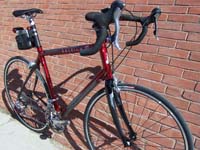 |
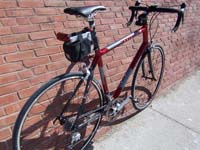 |
One of the things that most attracted me to this bike is the handlebars. They're Easton EA30, 31.8 size, multi-shaped. The oversized diameter permits the bars to be ovalized in ways that greatly add to the comfort. It may look as if this is about aerodynamics, but it's really about the comfort. The upper section of the bar is flattened out so as to provide a considerably greater surface contact area with the rider's hands. This greatly reduces the pressure on the hands, makes a big difference in hand/wrist comfort. I wish the bottoms had a traditional curve, instead of the ubiquitous "anatomic" sharp bend. When I'm on the drops the slanty part is too slanty for me, and the level part is too level. My hands want to go just where the crease is, but the bend there is sharper than I would prefer. Unfortunately, virtually all drop handlebars on the market these days are like this.
When Shimano went to 10-speed with 2004 Dura-Ace, they did a major re-design of the ergonomics of their brifters. The thing they most tout is that the shift levers move at a slight rearward angle as you push them sideways, conforming better to the sweep of the rider's fingers. This is a nice enough feature, but to me the greater improvement is the complete re-shaping of the brifter body. I was never a big fan of the 9-speed model. I ran an Ultegra set on my Hetchins for a while, but wound up removing it and installing Campagnolo Ergo instead.
The re-shaped 10 speed brifters work much better for me. In addition to a more comfortable normal hood position, they have added an extra riding position! The body sticks up a bit higher in front and provides a very nice place for the rider to grip so the side of the hand rests on top of the hood, and the lower fingers wrap nicely around the projecting top. This gives a position somewhat reminiscent of an aero bar, and I like it a lot as an alternate cruising position.
This design, introduced in 2004 Dura-Ace, "trickled down" to Ultegra when that group went 10-speed in 2005, and to 10-speed 105 in the 2006 modlel year.
Frankly the extra sprocket isn't that big a deal to me, but I like the 10-speed brifters' ergonomics very much. The extra position wrapping the bottoms of my fists around the projecting tops of the hoods is very nice...and I can even shift from that position, using my pinkies!
All in all, I'm quite well pleased with this bike. It isn't a "do-everything" bike but it isn't intended to be. For fast riding in nice weather it is an excellent choice in a functional, comfortable machine. It isn't a work of art like a traditional hand-built lugged steel frame, but as a tool for riding it works quite well indeed.
![]()
![]()
Being who I am, I couldn't leave this bike in stock configuration for long! The first thing I changed was the saddle, installing a Brooks B.17, titanium rail version.
I also added a camera mount to the stem, so I can take videos while I ride, using my new Kodak V570 camera.
I found the gearing basically satisfactory, but found I was getting confused going back and forth between this bike and my two bikes that have Campagnolo Ergo shifters, because on those bikes, the small lever behind the brake lever upshifts the rear derailer, while the corresponding lever on the Shimano STIs downshifts.
I've long been interested in low-normal rear derailers (that's what the first couple of derailers I ever used were, the old Cyclo Benelux models) but had never tried one (or even heard of anybody else trying one) with "road" STI brifters. Always ready to try something new, I bought a Deore XT low-normal rear derailer and installed it. I'm quite pleased with the results, and it's a less difficult mental adjustment than I had thought it might be. I just need to remember: Little Lever, Lower Gears; Big Lever, Bigger Gears. It's now the same on both sides of the handlebars, and I like that a lot.
Downshifting is maybe not quite as fast, as it tends to wait for the wheel to roll around so that the "gate" in the cassette is in the right position, but downshifting is smoother and seems more reliable than with the original Ultegra high-normal rear derailer. No problem with upshifting either. I really like this setup!
While installing the new rear derailer, I also added a gear indicator to the shift cable.
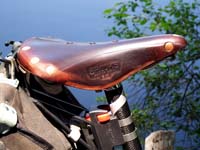 |
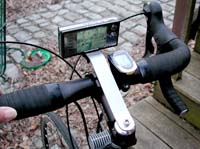 |
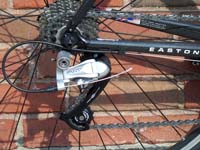 |
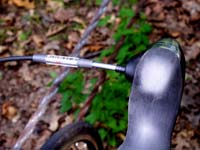 |
![]()
![]()
![]()
Last Updated: by Harriet Fell